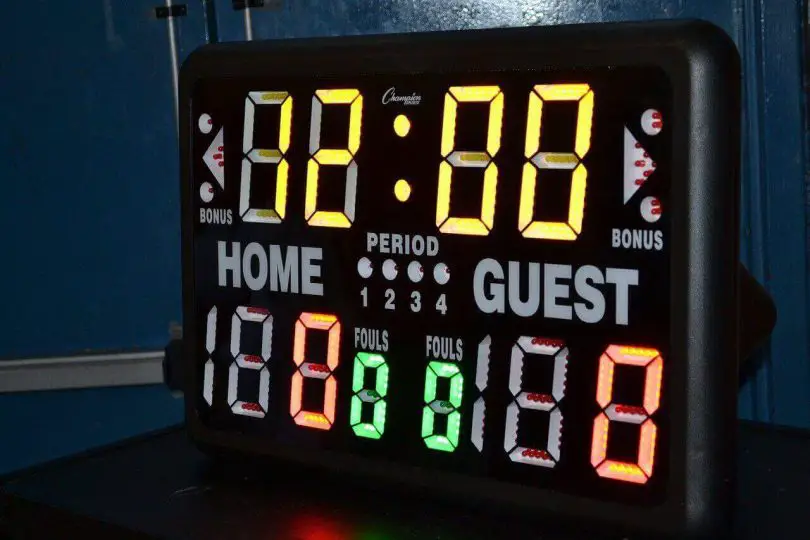When it comes to basketball, one of the most frequently asked questions is how many periods are in a game. The answer depends on the level of play and the league. In professional basketball, such as the NBA, there are four quarters, while in the WNBA, FIBA, and women’s NCAA basketball, there are four ten-minute periods.
Understanding the length and number of periods is crucial for both players and fans. It affects the pace of the game, the strategies used, and the overall flow.
Additionally, knowing the number of periods and the length of each period can help you plan your time and schedule accordingly.
Whether you’re a seasoned basketball fan or just getting into the sport, it’s essential to have a clear understanding of how many periods are in a game.
Understanding the Game of Basketball
Basketball is a team sport played between two teams of five players each, with the aim of scoring more points than the opposing team by shooting the ball through the opponent’s goal, which is an elevated horizontal hoop and net called a basket. The game is typically played indoors on a rectangular court.
The game is divided into four periods, each with a designated duration. In most basketball leagues, including NCAA men’s basketball games, regulation time consists of four periods.
Each of the first two periods lasts for 20 minutes, making up a total of 40 minutes for the entire half. During this time, each team tries to score as many points as possible while preventing their opponents from doing so.
After the first and third periods, there is a short break of two and a half to three and a half minutes, depending on whether the game is nationally televised or not. The length of the break is designed to give the players a chance to rest and hydrate before returning to the court for the next period.
It is important to note that the clock stops during certain situations in the game, such as when a player scores a basket, when a foul is called, or when the ball goes out of bounds. This means that the actual length of a period can vary depending on how many stoppages occur during the game.
In addition to the periods, there are also other important rules and concepts that players and fans should be familiar with. For example, there are different types of fouls that can be called, and each one has its own set of consequences.
Additionally, players must be aware of the different zones on the court, such as the three-point line and the free-throw line, and how they can be used to their advantage.
Overall, understanding the game of basketball requires knowledge of the rules, strategies, and techniques that are used by players and teams.
By familiarizing yourself with these concepts, you can better appreciate the skill and athleticism that are required to play the game at a high level.
Periods in a Basketball Game
Basketball is a game of periods, and each period is a crucial part of the game. In this section, we will discuss the periods in a basketball game, including the length of each period, the number of periods in a game, and the differences between professional and college basketball.
Professional Basketball
In professional basketball, there are four periods, also called quarters, in a game. Each period lasts for 12 minutes, and there is a break of 15 minutes at halftime.
During the game, teams get a quick breather in between periods, and players can rest for 2.5-3.5 minutes each time the 1st and 3rd periods are over. The break time is flexible because it depends on whether the game is broadcast on national television.
College Basketball
College basketball games are played in four periods, with each period lasting 10 minutes. The game structure is akin to professional basketball, with the first two quarters constituting the first half, and the last two quarters constituting the second half. There is a substantial break after the second period, and each team can take a 30-second timeout per half.
It is crucial to note that the number of periods in a basketball game can differ based on the level of play and the league. For instance, women’s NCAA basketball games are played in four, 10-minute periods, and FIBA games are also played in four, 10-minute periods.
Basketball Overtime Rules
In basketball, overtime occurs when two teams are tied at the end of regulation. The number of periods in overtime can vary depending on the league and level of play. Here are the overtime rules for the NBA, NCAA, and FIBA:
NBA Overtime Rules
In the NBA, when the score is tied at the end of regulation, the teams play a five-minute overtime period, which begins 130 seconds after the end of regulation. If the score remains tied after the initial overtime period, the teams play another five-minute period, and this cycle continues until one team emerges victorious.
Each team is allowed one additional timeout in overtime, and team fouls reset at the start of each overtime period. If a player fouls out in overtime, they cannot be replaced.
NCAA Overtime Rules
In NCAA basketball, overtime is played for one five-minute period. If the score remains tied after the initial overtime period, another five-minute period is played, and this process continues until one team emerges as the winner.
Each team is allowed one additional timeout in overtime, and team fouls reset at the start of each overtime period. If a player fouls out in overtime, they cannot be replaced.
FIBA Overtime Rules
FIBA basketball games have one five-minute overtime period, and if the score is still tied after the initial overtime period, another five-minute period is played. This pattern continues until one team emerges as the winner.
Each team is allowed one additional timeout in overtime, and team fouls reset at the start of each overtime period. If a player fouls out in overtime, they cannot be replaced.
Impact of Periods on Game Strategy
The number of periods in a basketball game has a significant impact on game strategy. Each period provides an opportunity for teams to adjust their approach and make necessary changes to their game plan. Here are a few ways that the number of periods affects the game strategy:
- Fatigue Management: The length of each period and the number of periods in a game can affect how players manage their fatigue. For example, in a game with four 12-minute periods, coaches may choose to rest their star players for a few minutes during each period to ensure they have enough energy for the later stages of the game.
- Scoring Opportunities: The number of periods in a game can also affect the number of scoring opportunities for each team. In a game with four 12-minute periods, teams have more opportunities to score than in a game with two 20-minute halves. This can influence the pace of the game and the types of shots that players take.
- Game Flow: The number of periods can also affect the flow of the game. In a game with four periods, teams have more opportunities to make adjustments and change their approach. This can lead to more back-and-forth action and a more exciting game for fans.
- Foul Management: The number of periods can also affect how coaches manage their players’ fouls. In a game with four 10-minute periods, for example, coaches may be more cautious about playing players with multiple fouls, as they will have fewer opportunities to make up for lost time.
Overall, the number of periods in a basketball game has a significant impact on the game’s strategy and flow. Coaches must take into account the length of each period and the number of periods in a game when developing their game plan. Players must also manage their fatigue and fouls throughout the game to ensure they are at their best when it matters most.
Variations in Different Leagues
Different basketball leagues have their own rules regarding the number and length of periods in a game. Here are some of the variations:
- In the NBA, games are played in four quarters, each lasting 12 minutes. There is a break of two and a half to three and a half minutes after the first and third quarters, depending on if the game is nationally televised or not.
- For the WNBA, NCAA, and FIBA, games are played in four 10-minute quarters, with the length of the break depending on whether the game is nationally televised or not.
- NCAA games consist of two 20-minute halves, totaling 40 minutes of regulation time, with overtime periods lasting 5 minutes.
- FIBA games are played in four 10-minute quarters, with breaks of two minutes between the first and second periods, and 15 minutes for halftime.
It is important to note that the length of the periods and breaks can vary based on the level and location of play. For example, high school basketball games may have shorter periods than college or professional games.
Knowing the rules of the league you are playing or watching can help you better understand the game and appreciate the nuances of the sport.







